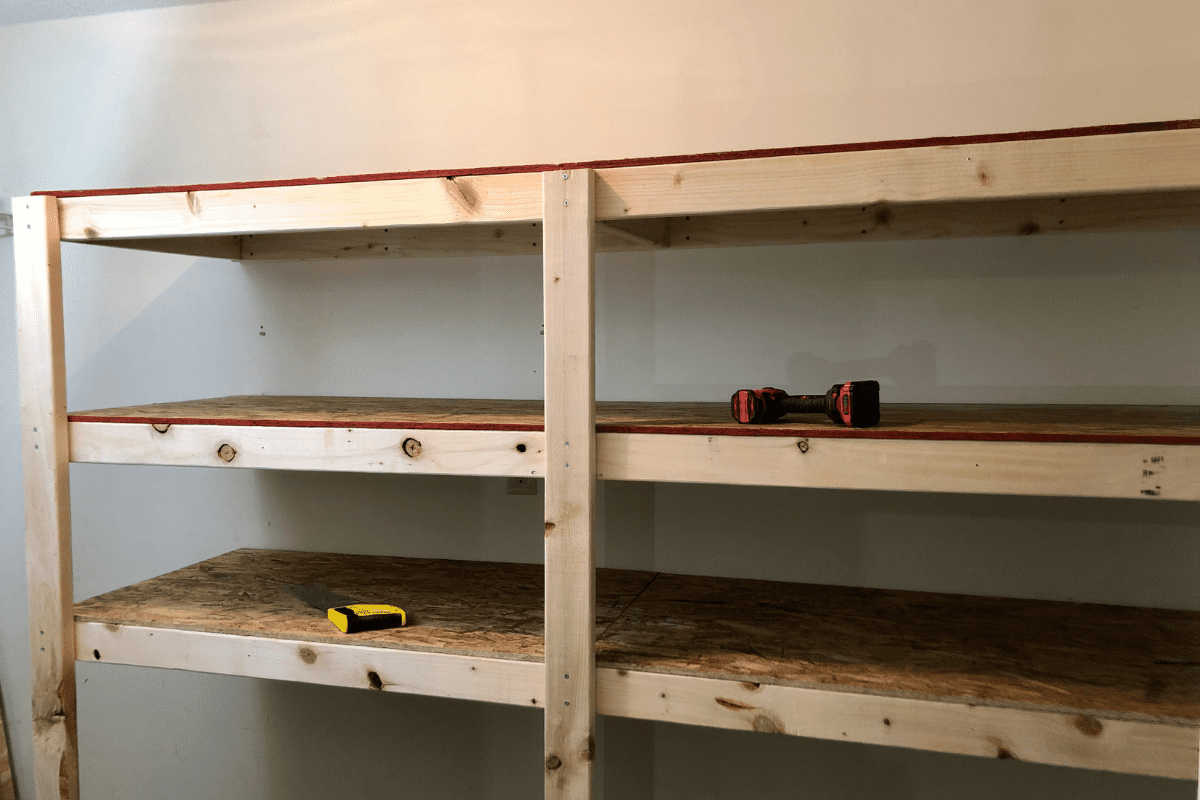DIY Garage Gym Storage Shelves (How To w/Pics)
Sooner or later as your garage gym continues to grow and you continue to accumulate more equipment, you’re going to need a good storage solution. A good set of shelves is a great solution to organize all of your accessories that are taking over every inch along the edges of your space.
A good set of DIY Garage Gym Storage Shelves will be able to hold Med Balls, Bands, Chalk, Shoes, Belts and even Kettlebells and Dumbbells. But, why is building your own shelf better than just buying one?
There are two reasons you should build your own garage gym storage. Only by building it yourself can you customize the exact dimensions and you’re going to end up saving a ton of money.
Every garage setup is different and every garage gym setup is absolutely different. We all have different amounts of space in our garage including lengths, widths and height. We also have different equipment. What works perfectly for my gym may not work at all for yours.
When you buy a storage shelf rack straight from Lowe’s or Home Depot, you get what you get.
By building your own storage shelves, you can customize your shelf to fit your space – perfectly. Want a shelf rack that’s 5 1/2 feet wide, 9 feet tall, 1 1/4 foot deep with 4 shelves? You can build exactly that. Good luck with finding that shelf at the store.
Second, price. The shelf I built, the one I’m going to walk you through is 6 feet tall and 8 feet wide. (Your size can be different, but the principles I use will still be the same). The total cost ended up being less than $100.
The closest equivalent at Lowe’s is a 7×7 (again, customization in building your own is unbeatable). Cost? $249.
I know that for many though, there is one big drawback to building your own. Actually building it.
I’m here to tell you though that this build is NOT HARD! I’m not saying you’ll have it built in an hour, but you can definitely knock this out on a Saturday.
You also don’t have to have an extensive tool chest to pull this off either. A cordless drill is the most ‘hi-tech’ tool you’ll need for this project. Other than that, you can put this together with a stud finder and leveler. (This is if you get the friendly folks at your local lumber store to cut your pieces for you which I HIGHLY recommend.)
Now, let’s walk through how you can build a DIY Garage Gym Storage Shelf just like the one I have.
DIY Garage Gym Storage Shelf Materials
**Materials for your shelf may differ depending on the size of the shelf you plan to make.** This should all become clear as we go through.
Scroll down and complete Step 1 before buying any materials!
- Cordless Drill
- Stud Finder
- Leveler
- Saw (Get your boards cut at the store and you can forget about the saw)
- 11 – 2x4x8 boards
- I then had some of these boards cut to size. What I ended up with was:
- 6 – 2x4x8 boards
- 3 – 2x4x6 boards
- 9 – 21″ 2×4 boards
- 3″, 2 1/2″ and 1″ Wood Screws
Fun Fact: Did you know that you can buy two 2x4x8s cheaper than you can buy one 2x4x16? It flies in the face of conventional wisdom. Generally, if you buy something bigger, it’s cheaper. Not the case here. Not totally sure why to be honest. I’m guessing something to do with shipping 16 foot boards being tougher.
Anyways, just wanted to share for those who may not know (like I didn’t until this project)
Building The Shelf
Step 1 – Find Your Studs, Plan Your Shelf & Measure Everything
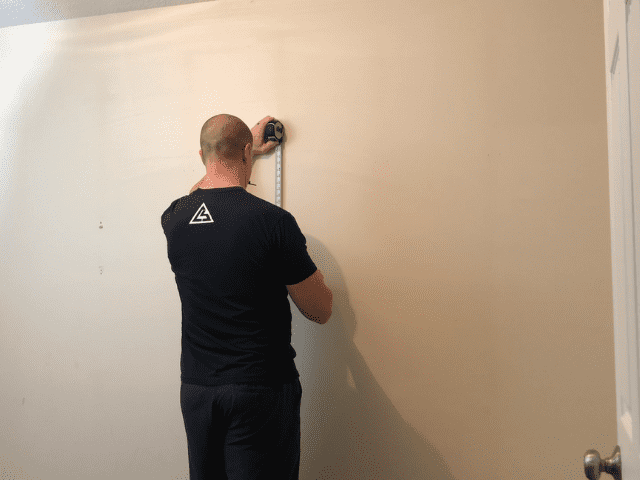
Before you go buy any materials, we need to first figure out where we want to build our shelving unit and how big we want it to be. This shelf will be attached to the wall so you need to be sure you’re putting it exactly where you want it. There will be no ‘moving it around’ once we’re done.
Once you’ve picked out your wall and space, find and mark all your studs. I recommend making small marks for each stud for each shelf to make things easier later on.
Measure everything out so you know exactly what you need material-wise.
Here are my dimensions and materials:
3 Tier Shelf (including the top) with plenty of space underneath for large, heavy objects. 6 feet long, 8 feet tall and 2 feet deep.
11 – 2x4x8s
These 2x4s will create the entire framework for your shelf. I kept 6 of the 2x4s at 8 feet long and they served at as the horizontal boards. 3 anchored against the wall and 3 that made up part of the front of the shelf.
3 of the 2x4s were cut down to 6 feet. They served as the 3 vertical boards for the front of the shelf.
Finally, 9 21″ boards were cut out of these 2x4s to make the connection boards for the front and the back of the shelf.
Step 2 – Anchor the Back Boards to the Wall

Decide where you want your shelves to be (and how many). Use a leveler to line up and make sure your boards are, well, level. Finally, drill those boards into the studs. I used 3″ Wood Screws for this step.
Step 3 – Build the Front of your Shelf
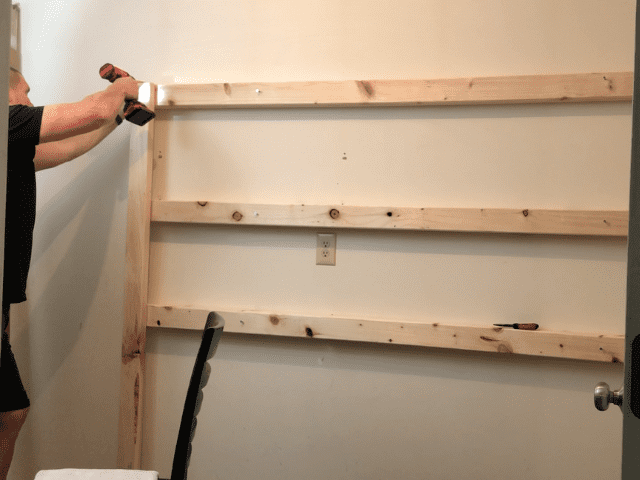
The first thing we’re going to do is temporarily drill three 8′ boards directly on top of the back three boards. I put two screws (2 1/2″) through each board, not all the way in, just far enough to secure it in place on top of the back board.
Now, we’re going to put our three 6′ vertical boards in place. Place one on each side and one down the middle for added support. If your shelf isn’t as wide as mine, you may not even need the center vertical board. If it’s longer, you may need more. Use your best judgment.
Remember, the heavier the objects you plan to place on the shelves, the more support they need. Shoes and jump ropes – not as much. Kettlebells and Med Balls? You’re going to need a bigger boat.
Once your vertical boards are in place then go back and remove the screws that are holding the horizontal boards together.
You can now remove the front half of the storage shelf. Because of how we placed one set of horizontal boards right on top of the other, we have guaranteed ourselves that our shelves will be lined up perfectly level when we re-attach the front half of the shelf later on.
Step 4 – Add the Connector Boards

Now we’re going to use angle drill holes to connect our nine 21″ boards to the back boards against the wall. Three boards will go on each horizontal board. They should be lined up with where the vertical boards are on the front piece.
These connector boards will essentially connect the front half and the back half of the frame. They’ll also add stability and structure to our plywood shelves that we’ll be sitting on top in just a moment.
Really quick on why 21″. OSB and Plywood come in 4×8 sheets. For the sake of cost efficiency, I’m making my shelves 2 feet deep. The OSB Boards are going to not just sit on the connector boards, but also the 2x4s on the front and back of the frame. Since the front and the back of the frame are both 1 1/2″ wide, a 21″ connector board will make a 2 feet wide piece of plywood sit perfectly flush.
Pre-drill angle holes into both sides of your boards to make screwing them into the horizontal boards possible. If you’ve never done angle holes before, don’t worry, I never had either until this project. It can be a little intimidating, but it’s really not that hard once you get the hang of it. If you have a scrap piece of 2×4, do a couple of test runs before your first ‘real’ one.
You could always go with brackets if doing angle holes is something you have no interest in trying. It will make your shelves a little more expensive to complete, but brackets should do the job just fine.
Step 5 – Attach the Front of the Frame
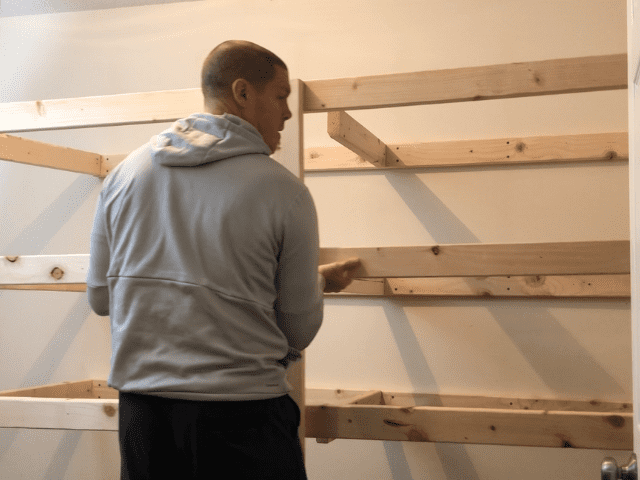
Now it’s time to bring the front half of the frame back in and attach it to the rest of the shelf. This is a pretty easy part of the process.
Simply line up the front of the frame so that the vertical boards line up directly with the connector boards. Double-check the sides as well to make sure your frame is even lengthwise.
We shouldn’t have to worry about height at all since we literally lined up our horizontal boards when we built out the front of the frame.
Once you have it perfectly lined up, drop in your angle screws to the front of the frame just like you did with the back of the frame.
Step 6 – Drop in the Shelves
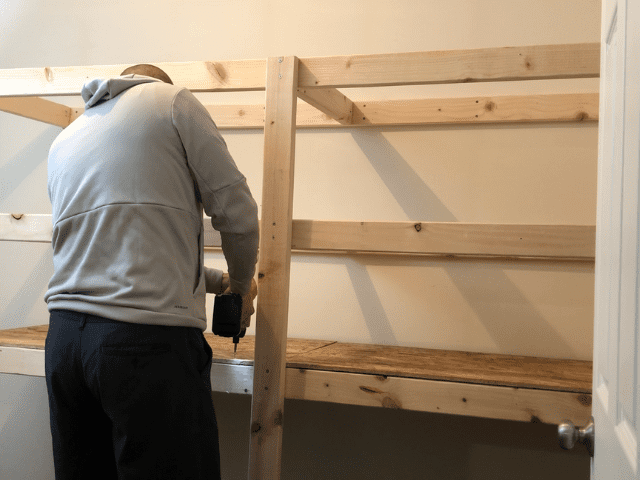
At this point, we’re almost home free. The last thing we need to do is drop in our OSB Boards, or plywood, to create our actual shelves.
If you’ve measured everything properly you should be able to slide these boards right into place. Then drop a few 1-inch screws to secure them to the frame they’re sitting on.
Step 7 – Bask in the Glory of your New Gym Shelves
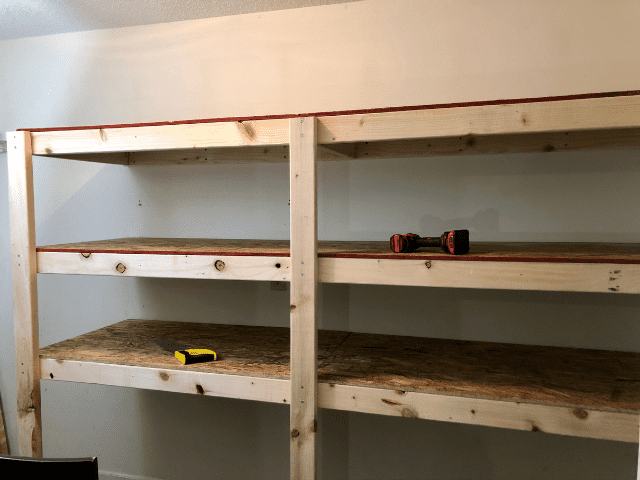
In 6 steps we just took simple materials along with simple tools and ended up with some kickass garage gym shelves. Sit back and enjoy your work. You’ve earned it!
Final Thoughts
Why did I choose to DIY my own Gym Shelves rather than just buy them? In one day’s worth of work and for less than half the price, I have a set of custom-sized, custom-designed shelves that are perfect for my space and my needs.
With all that being said, why wouldn’t you want to build your own DIY Garage Gym Storage Shelves???
Stay Strong!

